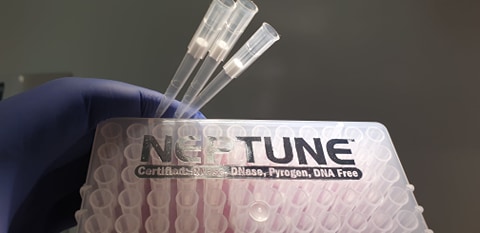The production of polyclonal antibodies is carried out from a mixture of B lymphocytes with an affinity for different epitopes of the same antigen. And it is precisely this characteristic, the ability to recognize multiple epitopes of a certain antigen , which is an advantage over monoclonal antibodies in some assays, such as immunoprecipitation.
In this post, we will review the key factors that influence the production of polyclonal antibodies , including the antigen and its characteristics, immunization protocols and the use of adjuvants, among others.
When carrying out the production of polyclonal antibodies , there are some steps in the development process that are critical:
- Antigen preparation
- Selection of animal species
- Preparation of the adjuvant
- Immunization protocol
- Antibody collection
- Purification of polyclonal antibodies
Let’s look at each of these points in more detail:
1.- PREPARATION OF THE ANTIGEN
Before starting the production of polyclonal antibodies, it is important to evaluate the antigen characteristics in terms of quantity and quality, as well as its preparation. The three main factors to consider are:
- Quantity
The amount of antigen injected into the animal is directly related to the immune response to be triggered. Too high or too low amounts of antigen can induce suppression, sensitization, tolerance, etc.
The usual amounts for immunization range from micrograms to milligrams, depending on the animal to be immunized, the route of administration, the immunization schedule and the characteristics of each particular antigen.
- Purity
The purity of the antigen directly affects the specificity of the immune response, since even small impurities can be immunodominant, giving rise to antibodies that are more active against the impurities than against the antigen of interest.
Therefore, the higher the purity of the antigen, the more specific the polyclonal antibodies generated will be.
- Toxicity
It is very important to ensure that the preparation containing the antigen does not contain toxic substances such as endotoxins, chemical residues, extreme pH levels, etc. This type of contaminants can negatively influence both animal welfare and immunological results.
To finish this section, we remind you of this previous entry with some keys to obtain good antibodies: the antigen

2.- SELECTION OF ANIMAL SPECIES
To select the most suitable animal species for the production of polyclonal antibodies, three factors should be taken into account:
- The amount of antibody needed and the ease of bleeding of the animals
The most commonly used species for the production of polyclonal antibodies is the rabbit, because it is an easy-to-handle animal and produces antibodies with high affinity and high titration.
When larger amounts of antibody are required, animals such as sheep or goat, or chickens are often used (Remember this post on 5 reasons to use chicken antibodies ).
- The phylogenetic distance between the antigen and the animal species
The selection of the animal in which the production of polyclonal antibodies is carried out is also influenced by the animal species from which the antigen of interest comes. The greater the phylogenetic distance between the two species, the better the immune response that is awakened.
- The application or technique in which the polyclonal antibody is intended to be used
It is also important to pay attention to the final application of the antibody to be generated, since in some cases it could influence the selection of the animal species. This is especially important in those tests where a secondary antibody is going to be used, since both must be generated in different species.
To finish this section, we leave you this previous entry on Species for the production of antibodies, which is better?
3.- PREPARATION OF THE ADJUVANT
Adjuvants are mixtures of substances that are used to stimulate and amplify the immune response. On the one hand, they enable the production of polyclonal antibodies from poorly immunogenic antigens, and on the other, they allow the administration of lower doses of antigen to animals.
There are many adjuvants used for this purpose, although the most frequently used are Freund’s complete adjuvant (FCA), Freund’s incomplete adjuvant (FIA) and aluminum salts.
When preparing the adjuvant-antigen mixture, it should be remembered that it must be done in aseptic conditions to avoid contamination, and monitor the stability and quality of the emulsion.
4.- IMMUNIZATION PROTOCOL
The route of administration of the antigen depends on the animal species and on the characteristics of the antigen and the adjuvant.
The most frequent routes of administration are:
- Subcutaneous (sc): It is the most frequent route of administration, and supports relatively high administration volumes.
- Intramuscular (im): It has the advantage that absorption is faster. However, it is more painful for the animal and can damage the sciatic nerve.
- Intraperitoneal (ip): Supports relatively high administration volumes, but there is a risk of anaphylactic shock. This route is not recommended in the case of larger animals such as rabbits, sheep, goats, etc.
- Intravenous (iv): It has the advantage that the distribution of the antigen is carried out very quickly, but it also increases the risk of anaphylactic shock.
- Intradermal (id): Increases the efficiency in terms of antigen processing, although it is more painful for animals. This route is not recommended in the case of small rodents such as rats and mice.
Regarding the injection volume , you should always opt for the smallest volume capable of arousing the immune response. This will vary depending on the characteristics of the antigen, the animal species and the route of administration.
5.- COLLECTION OF ANTIBODIES
In the case of mammals, a series of bleeds can be scheduled during the immunization schedule, in order to assess the animal’s immune response and the production of polyclonal antibodies.
The volume of bleeding should not exceed in any case 10% of the total volume of circulating blood, and between one and another bleeding a period of rest of about 3 or 4 weeks must be respected.
6.- PURIFICATION OF POLYCLONAL ANTIBODIES
Once the antiserum has been obtained, it may contain cellular residues or non-specific immunoglobulins, among others, that can condition the correct functioning of polyclonal antibodies. Therefore, it is essential to carry out a purification process.
This purification can be carried out by protein A or G affinity chromatography, or in case you want to eliminate more background noise by nonspecific binding, an affinity purification can be performed with the antigen, thus isolating the monospecific polyclonal antibodies.
In closing, we remind you of this previous entry on Antibody purification methods .

